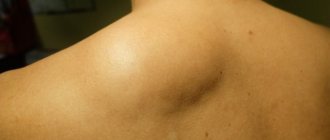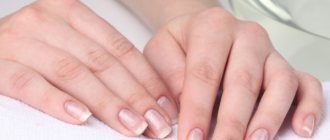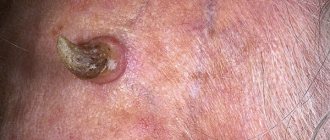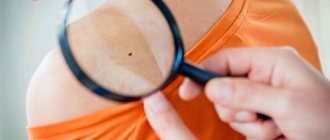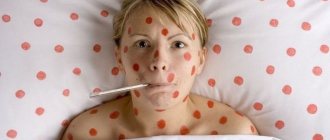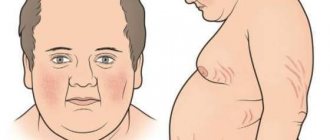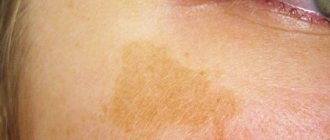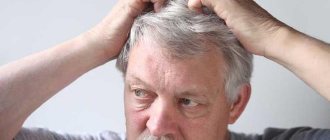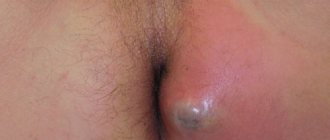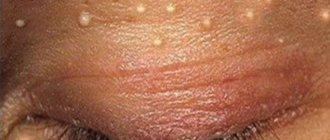Papules on the face are small formations of the skin that look like nodules. This rash occurs on the skin regardless of age and gender. It can be a harmless cosmetic defect and a symptom of a serious disorder in the body. If such a phenomenon is detected, you should seek advice from a specialist.
What are these and types of papules on the face
Pools are usually called any formations on the skin that are small in size, oval in shape and slightly rise above the tissues. Such compactions occur in groups, but may be present in a single specimen.
Classification of types of papules occurs according to several criteria:
- By tumor size
Miliary - have the shape of a cone. They are small in size (like millet). They can be located in an arc or circle. Most often they are located in the area of hair follicles. The growths are called “goose bumps”. Lenticular - resemble lentils. They have a flat round shape. Their size does not exceed 5 millimeters. Nummular - large elements. They can reach the size of a coin up to 2 centimeters. They arise as a result of the fusion of small papules or form independently. Papules are most common on the chin. When they grow into folds of the skin, they can become damaged and lose the top layer. In this case, oozing wounds occur with the transition to the formation of ulcers.
- By placement depth
Superficial – flat growths with a size of no more than 5 millimeters. They are pink or red in color. They arise due to disruption of the functionality of the upper layer of the epidermis. Do not cause pain. Deep - appear between the layers of the epidermis and dermis. May have a reddish or bluish tint. When pressing on such a papule, an unpleasant painful sensation is felt. Cysts are inflamed capsules. Formed if the infiltrate does not completely come out. If an infectious disease is associated with this phenomenon, the risk of suppuration and swelling is inevitable.
- By nature of manifestation
Inflammatory - characterized by swelling of the nearest integument. When pressed, the skin turns pale, but the papule does not disappear. Local hyperthermia is felt. Such formations take place independently. Not inflammatory. They are characterized by the proliferation of dermal layers, which leads to deformation of the skin and has irreversible consequences. With this type of papules, mandatory treatment by a doctor is required.
Miliary syphilide with syphilis
A rare type of papules.
They are characterized by a small size - no more than 2 mm.
Nodules appear with syphilis, located at the mouth of the hair follicles.
They are round or cone-shaped.
Very dense and can peel off.
Horny growths may form on their surface.
A characteristic feature is a weak color.
Miliary papules are pink, or even comparable in color to the surrounding skin.
Therefore, they are difficult to detect.
They are located mainly on the body.
Sometimes accompanied by itching.
They appear mainly in sick and weakened patients, as well as in people who abuse alcohol.
Even with specific therapy, the nodules do not go away for a long time.
And when they do disappear, atrophic (below the skin level) scars form in place of the miliary papules.
Symptoms and causes of papules on the face
Papules on the skin of the face are an unpleasant phenomenon that brings a lot of inconvenience. Both physical and psychological discomfort arises. Such formations cannot be hidden under a layer of makeup, and home recipes for eliminating them are absolutely ineffective. The appearance of papules can be recognized by the characteristic elevation of individual areas of the skin. If the disease is not inflammatory in nature, the person will notice the absence of pain. The lesions may appear as lumps that are quite hard and cannot be moved. If an infection is attached to the formations, an unpleasant sensation will arise. Red swelling may appear, and the temperature of the affected area will differ from the general temperature. The longer the growths remain under the skin of the face, the larger they will become. Consequently, the damage caused by their presence will increase in proportion to the time the person waits.
Formations can arise for various reasons. The provoking factor for this phenomenon is the presence of microbes. This is mainly a staphylococcal bacterium that causes an inflammatory process in tissues.
Occurs under the influence of the following factors:
- Disturbances in the hormonal background of the body. A similar phenomenon can occur under the influence of age-related changes in the body, various diseases or emotional stress.
- Dysfunction of the sebaceous glands. May occur under the influence of unfavorable external factors. For example, the ecological environment, contact with hazardous substances. The process is also affected by the deposition of cholesterol in skin tissues.
- Dysfunctions of the gastrointestinal tract. Occurs in diseases that affect the body's metabolic processes. Also due to improper unbalanced nutrition.
- Busy lifestyle. Inadequate psychological emotional rest, the presence of stress and nervous breakdowns.
A person without special education will not be able to distinguish ordinary acne from papules. For proper diagnosis and treatment, the patient should seek help from a doctor. Self-treatment, without a correct diagnosis, can significantly complicate the situation.
Pearly papules treatment in men
Pearly papules are small bumps that can form on the ridge of the glans penis. They are a simple anatomical change. At the same time, I should note that penile papules are a natural part of the anatomy of your penis.
You can live with them as they will not bother you and are not associated with any health hazard.
Before diving deeper into the problem, let me reassure you that the appearance of Pearly Papules is completely normal for most men, and a small number of them is a completely normal physical condition.
Also, the disease itself cannot lead to any dangerous consequences, either for sexual life or for a man’s health in general.
Keep reading to learn about the causes, symptoms, diagnosis and proper treatment of pearly papules in men!
Pearly papules in men
Pearly papules appear to be small pimples on the ridge of the head of the penis. They appear in several rows in a small group measuring less than 1 - 3 mm, forming one or two rows on or around the head of the penis.
They may vary in color and may appear pink, yellow, white, or sometimes clear in appearance, and are shaped like small pearls.
Pearly papules are also known as Hirsutoid Papillomas or Hirsutism Crowns Glandis People often make the mistake of confusing them with Genital Warts and also thinking that the papules are sexually transmitted.
People, don't be afraid! Since it is not a disease, whether or not to remove it is your personal preference, and may be considered a cosmetic step rather than a treatment.
Another major problem that might scare you is surgery to remove Pearly Papules, but you should not opt for surgery for a minor problem like papules.
There are much simpler methods to solve this problem, which we will discuss later in this article.
How common is the problem of penile papules in men?
Poll: When did your acne appear? (Qty: 4295)
I've been suffering all my life
It's been a couple of years now
About a few months
Recently
To answer, click on the desired answer option. results
You are not alone! This is a fairly common problem, especially among young men in their twenties and thirties. Papules appear or have appeared at various times in 30 to 48% of all men. It also occurs mainly among a large category of uncircumcised men.
After extensive medical analysis, leading US clinics concluded that papules were found in 33.3% of uncircumcised men and 7.1% of circumcised men.
Before choosing any treatment option for Pearly Papules, you must first diagnose the conditions and causes of the papules as accurately as possible.
The best way to do this is to consult a doctor about your problem and undergo the entire course of treatment under his strict guidance.
Ordinary people often mistake pearly papules for Genital Herpes, which is a significant mistake when treating them independently.
It is quite difficult to identify and distinguish between these two diseases on your own. Therefore, before starting treatment, first make sure that your diagnosis is correct so that you do not apply the correct treatment if the diagnosis is incorrect.
Although the wrong effects of treatment can be easily corrected, it is still for your own good to carry out treatment, no matter how promising, only with the approval of a doctor.
Pearly papules photos in men
Treating pearly papules at home
Natural remedies are always the best to get rid of penile papules. Home treatment options are much better than surgical intervention, which is relatively more dangerous, more expensive, and which requires constant monitoring by doctors.
Use Castor Oil
To begin the procedure, make sure that the penis is dry and clean. Apply a little castor oil using cotton swabs to the affected areas 3 - 4 times a day. Continue treatment until all papules are completely removed.
This method is very safe and guarantees complete removal of pearly papules in men. It is also important to find a reliable manufacturer, and not a fake, before buying a bottle of castor oil.
Use Triple Antibiotic Ointment
Ointment is needed for a safe way to get rid of bumps and papules on the penis. This ointment, as the practice of its use proves, is quite effective.
Apply it to the affected areas at least twice a day, leaving twelve hours between applications.
Ointments for genitals
Traditional medicine also offers us many recipes for ointments and masks that combat genital problems in men.
In the case of papules, the most common is a homemade ointment made from honey, aloe juice, sea buckthorn oil and crushed mummy tablets in powder form mixed together.
The contents are heated over a fire, and then cooled to room temperature and applied to the areas where pearlescent papules are formed for 10 - 15 minutes.
Surgical methods for removing pearly papules in men
The presence of pearlescent papules is no secret, which causes anxiety and perhaps even stress and sexual dissatisfaction in most men. And often a man decides to remove the papules surgically for a faster and better treatment effect.
https://www.youtube.com/watch?v=pW9542vQPiY
To begin with, of course, it is important to make certain diagnostics and take tests to establish a diagnosis by a dermatologist and the subsequent course and method of treatment. Although an experienced doctor, in order to identify pearlescent papules, only a visual examination of the patient and the head of the penis is sufficient.
In more rare cases, the patient will first be required to undergo a biopsy.
It is also worth noting that with any surgical method of removing pearlescent papules, a man does not have to be in a hospital; one can only get by with regular examinations and consultations with the attending dermatologist or urologist.
Pearlescent papules in men photo
The main methods for removing pearlescent papules that can be offered to you:
- cryotherapy.
- electrocoagulation;
- laser therapy;
- Typically, the choice of treatment method will depend on the direct recommendations of the doctor and the financial capabilities of the patient. If the latter is found to have additional diseases accompanying pearlescent papules, and these could be diseases of the diuretic system, kidneys or testicles, treatment, as a rule, begins with a more serious one problems, but end up with a milder one, such as papules.
With electrocoagulation, anesthesia is used, which removes the painful effect, and with the help of a device with a special loop at the end, the papules are captured and subsequently removed. The loop is preheated to a certain temperature and with the help of a current, the papules are cauterized, in place of which only a crust remains, which passes into over the next week.
When choosing a laser method, anesthesia is not used. The process is not very painful, and the laser itself removes papules on the head of the penis. The procedure is considered one of the most effective and safe in the treatment of such forms of diseases.
When choosing Cryotherapy, removal is performed with liquid nitrogen at a low temperature. It is worth noting that nitrogen is a safe chemical for humans.
It doesn’t matter which treatment method you choose, but in order to prevent complications, first of all, you need to adhere to careful personal hygiene - wash the penis only with wet wipes and do not wet the wounds with water. Do not rip off the scab from cauterization, which should fall off on its own within 1 - 1.5 weeks after the procedure.
I will tell you honestly and frankly that not a single doctor and not a single procedure can give you a 100% guarantee that pearlescent papules will not appear again, and you will again have to choose between surgical intervention, preventive treatment, or not resorting to do not use any of the methods and do not pay attention to the papules.
Source: https://doloipryshi.ru/index.php/udalenie-perlamutrovyih-papul-u-muzhchin-lechenie/
Features of localization of papules on the face
According to Eastern doctors, any neoplasms on the skin of the face indicate disorders in the internal organs. Domestic medicine also finds common sense in this, and is guided by the location of papules and pimples when diagnosing a patient.
We recommend reading:
- What is renal angiomyolipoma?
- Rules for caring for sutures after lipoma removal
- Causes of pustular pustules
A papule on the eyelid may indicate amyloidosis, molluscum contagiosum, Kaposi's sarcoma, malignancy, fibroma. You can also assume the presence of blepharitis, warts, or epithelial cysts of the sebaceous gland.
Papules on the skin of the forehead can occur as a result of hormonal imbalance in the body. They often occur during puberty and in pregnant women. A formation on the forehead may indicate a violation of metabolic processes in the body, improper functioning of the gastrointestinal tract. It should not be ruled out that the reason for the appearance of these formations is infection with scabies or herpes. New growths on the cheeks indicate many diseases. A similar symptom occurs with dermatitis or an allergic reaction. One can assume a ripening boil or lichen. The same is observed with chickenpox. A papule on the chin is a rather rare phenomenon, but it exists. Usually appears as a result of acne. May indicate blockage of the sebaceous ducts of the skin. The skin on the chin is quite dense; the contents of the capsule in which subcutaneous fat has accumulated cannot come out and matures inside.
A papule formed on the nose may indicate a disease such as baselioma. The disease tends to be complicated and therefore requires immediate diagnosis.
The neoplasm can be found all over the skin of the face and on the scalp. Concerns are caused by neoplasms under the eyes, in the area of the nasolabial fold. There are seals on the neck, behind the ears, on the lips, and indicate various diseases. Papules that appear on the head are a rarer phenomenon, but possible.
Lenticular papules in syphilis
The most common option.
It is observed in most patients in the first 3 years of the disease.
The resulting papules are round.
They have a diameter of up to 5 mm.
The outlines are clear and even.
The shape is round, and the relief is in the form of a hemisphere or a cut cone.
The color gradually evolves from pink to red and then acquires a yellow tint.
The legs may be cyanotic or purple.
At first, lenticular syphilide is smooth.
But over time, peeling may appear.
Biette's collar is a symptom of secondary syphilis, in which a rim of epidermis forms around the circumference of the scaly papule.
It appears when the papule begins to peel.
But then in its center the scales are rejected.
Jadassohn's symptom is a sharp pain if you press on a fresh papule.
But if you don’t touch it, there is no pain.
This form of syphilide is characterized by polymorphism:
- false - different elements are at different stages of their development in a separate period of time
- true - lenticular papules are combined with other elements of the rash
Main localization: stomach, back, arms and legs.
The arrangement is chaotic, but symmetrical.
If papules appear on the left leg, they also form on the right leg.
Much more of these elements are formed with fresh syphilis.
If we are talking about relapse, then there are few of them.
But the sizes are usually larger.
Crown of Venus is a symptom in which lenticular papular syphilide forms on the forehead.
The rash occurs where hair begins to grow.
Similar elements form on the neck in female patients.
Special types of lenticular syphilide:
Psoriasiform.
It has an appropriate name because the morphological elements of the skin are easily confused with a psoriatic rash.
The same silvery scales form on the surface.
But there are also differences.
The skin around the periphery of syphilis turns red.
If you scrape the element, then there is no classic psoriatic triad of symptoms.
Other features of the rash:
- not the same location as psoriasis
- plaques do not form
- no peripheral growth
Seborrheic.
It is characterized by the formation of fatty scales on the surface of papular elements.
They may have a yellow color.
They usually appear in people suffering from seborrhea.
This syphilide forms in areas of the skin where many sebaceous glands are located.
Regional.
A peculiarity is the appearance of papules only where there was previously primary syphiloma.
Appear as the first element of the secondary period.
That is, even earlier than the small spotted rash.
Treatment
How to get rid of papules? Treatment of skin formations in the facial area takes into account the root cause of this symptom.
If you treat only the external manifestations, without delving into the essence of the disease, the symptoms will soon return in full.
It is advisable to seek help from a doctor. Only a specialist can adequately assess the extent of the lesion and make a correct diagnosis based on clinical and laboratory studies.
Depending on the breadth of the rash, its shape and depth, treatment methods are selected individually. For minor lesions, only local treatment with a special anti-inflammatory agent will be required.
In case of widespread growths, when papules on the chin have spread to the neck, intravenous administration of medications will be required. If regular acne occurs, the patient will be prescribed antiseptic lotions, antibacterial creams, and multivitamins. It is also likely that an ultraviolet heating procedure will be needed.
Treating papules on the chin, cheeks or forehead on your own at home is strictly prohibited. Doing something like this without first making a diagnosis is extremely dangerous to your health. This is especially true for treating a child. Skin growths can occur due to a variety of diseases; wasting time on home healing attempts means putting your own health at risk. Before removing papules, undergo a series of tests to identify the cause.
On the recommendation of a doctor, the patient can independently purchase the necessary drug and, following the instructions, treat himself and his children at home. The patient is recommended to use Baziron or iodine. This is only relevant in cases of minor violations.
Diagnosis of syphilis
Syphilis is easily diagnosed at the primary or secondary stage in the presence of rashes and papules on the surface of the skin.
To make an accurate diagnosis, a tumor biopsy or microscopy may be prescribed.
This will allow the rash to be identified.
To confirm the diagnosis, laboratory tests are prescribed - PCR and ELISA.
They will also be repeated as control tests after treatment.
Preventive methods
To protect yourself from such a phenomenon, a person needs to take his health seriously. Proper nutrition, absence of bad habits, hygiene of one’s own body are the main factors influencing the strength of immune defense. It is necessary to wash your face regularly. This removes excess oil from the skin, preventing the chance of blockage. You need to take enough vitamins and microelements (iron, vitamin C, vitamin B, potassium, calcium, etc.). Only with normal nutrition will the body cope with all difficulties and recover quickly.
Papules on the face are not just a cosmetic problem.
They need diagnosis, because they may indicate complex diseases. If such a symptom appears, you need to visit a doctor's office soon. The article has been verified by the editors
Papular syphilide of the palms and soles
It differs in its location.
The rash appears very varied.
It is almost impossible to identify, or at least suspect a syphilitic infection, based only on these elements.
Papules can be located in groups, but can also be isolated.
Sometimes they form different shapes.
Some types of papular rash of palmoplantar localization:
Lenticular.
Lenticular papules appear.
They look like spots.
Because they almost do not rise above the surrounding healthy skin.
However, upon palpation it becomes obvious that there is an infiltrate in this area.
Scaling forms on lenticular papules.
They begin to form in the center.
Then they spread to the peripheral part.
They are very hard.
Papules are separated from the surface with great effort.
Ring-shaped.
Symptom of recurrent syphilis.
Rings and other shapes are formed around the fingers.
It is the result of the grouping and merging of many elements.
Horny.
Formations resembling a callus appear.
They are hard and have a stratum corneum on the surface.
There may be a depression in the center.
Wide.
Large plaques.
They differ in shape and size.
Covered with a stratum corneum.
There is no pain, itching or inflammation.
This is the result of constant mechanical irritation.
How do acne form?
Acne, papules and blisters can appear due to various diseases. The nature of the rash on the body is very important for diagnosing measles, chickenpox and other infections. But the main types of acne on the face are symptoms of acne - a disease of the sebaceous glands and the entire skin.
Characteristic signs of acne are enlarged pores, oily sheen, comedones and pimples. These symptoms occur when the exfoliation of dead cells is impaired and the sebaceous glands are highly active (oily seborrhea).
Horny scales of the epidermis, particles of dirt clog the pores, and comedones are formed in the form of whiteheads and blackheads. Acne propionobacteria, which constantly live in the irregularities of the epidermis, rush into the ducts of the sebaceous glands and the canal of the hair follicle.
When microbes multiply vigorously, they provoke inflammation. Blood flow to this focus begins, redness and swelling of the tissue occurs.
This is how various types of acne form on the face and their treatment necessarily takes into account changes in the affected area of the skin. Astringents, keratolytic and sebum-regulating agents help with enlarged pores and blackheads with oxidized and darkened sebum. Antibiotics, retinoids, and benzoyl peroxide are used to reduce inflammation.
Acne classification
Uninflamed
A closed comedon is a small bump without a cavity. Appears under the top layer of skin at the location of the pilosebaceous follicle.
An open comedon is an accumulation of sebum and keratin scales in the pores of the skin. Black dots got their name because they turn dark when the pigment is oxidized by oxygen in the air.
Inflamed pimples
A papule is a dense red bump measuring 5 mm or slightly larger. Often painful sensations associated with inflammation.
A pustule is a pimple with pus inside, which is visible from the outside as a white top with a red rim.
Dermatologists often call these types of acne papulopustules. It appears at the site of an inflamed comedon, and after squeezing and improper healing, traces (spots, scars) remain.
Bubble (vesicle)
The rash element has a cavity filled with serous or serous-hemorrhagic fluid.
Knot
Occurs when the affected area of skin grows and covers neighboring tissues. This is a very painful pimple that leaves a scar on the skin.
Cyst
The painful element of acne, difficult to treat. Color - red-brown or bluish. Inside there is a cavity with pus that has grown in volume.
